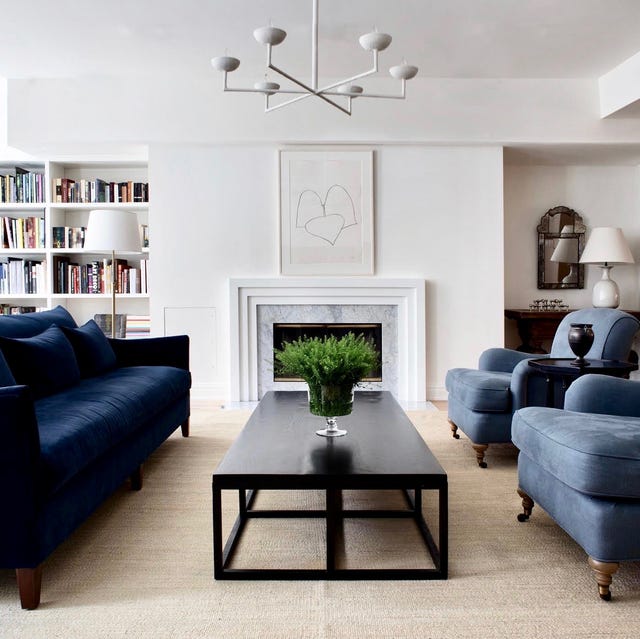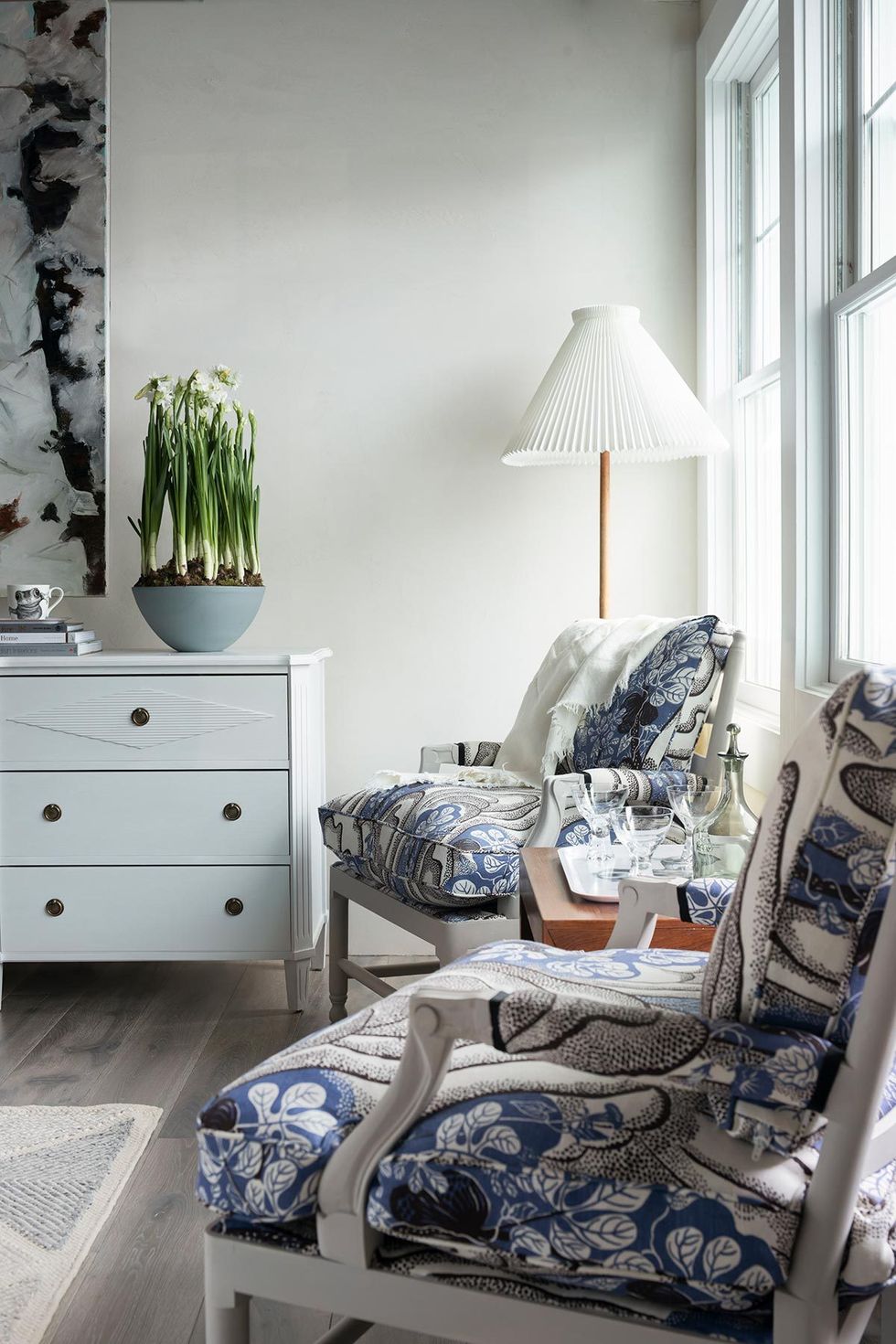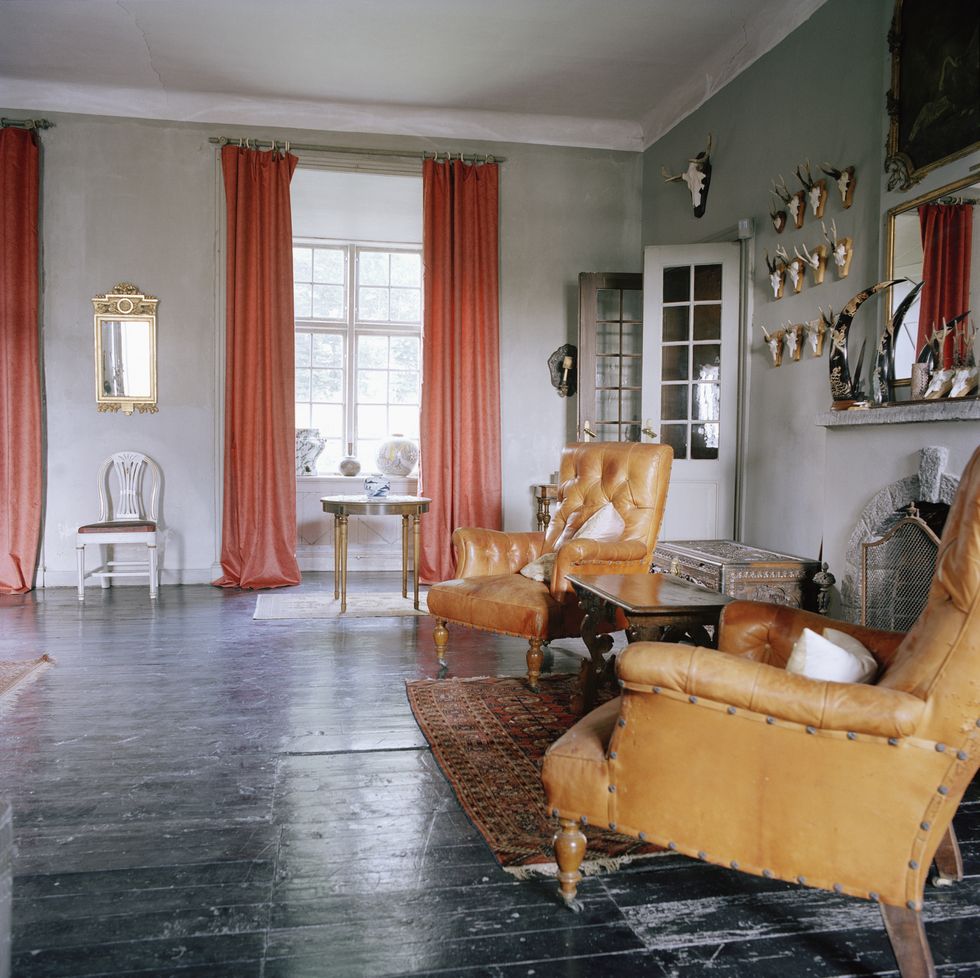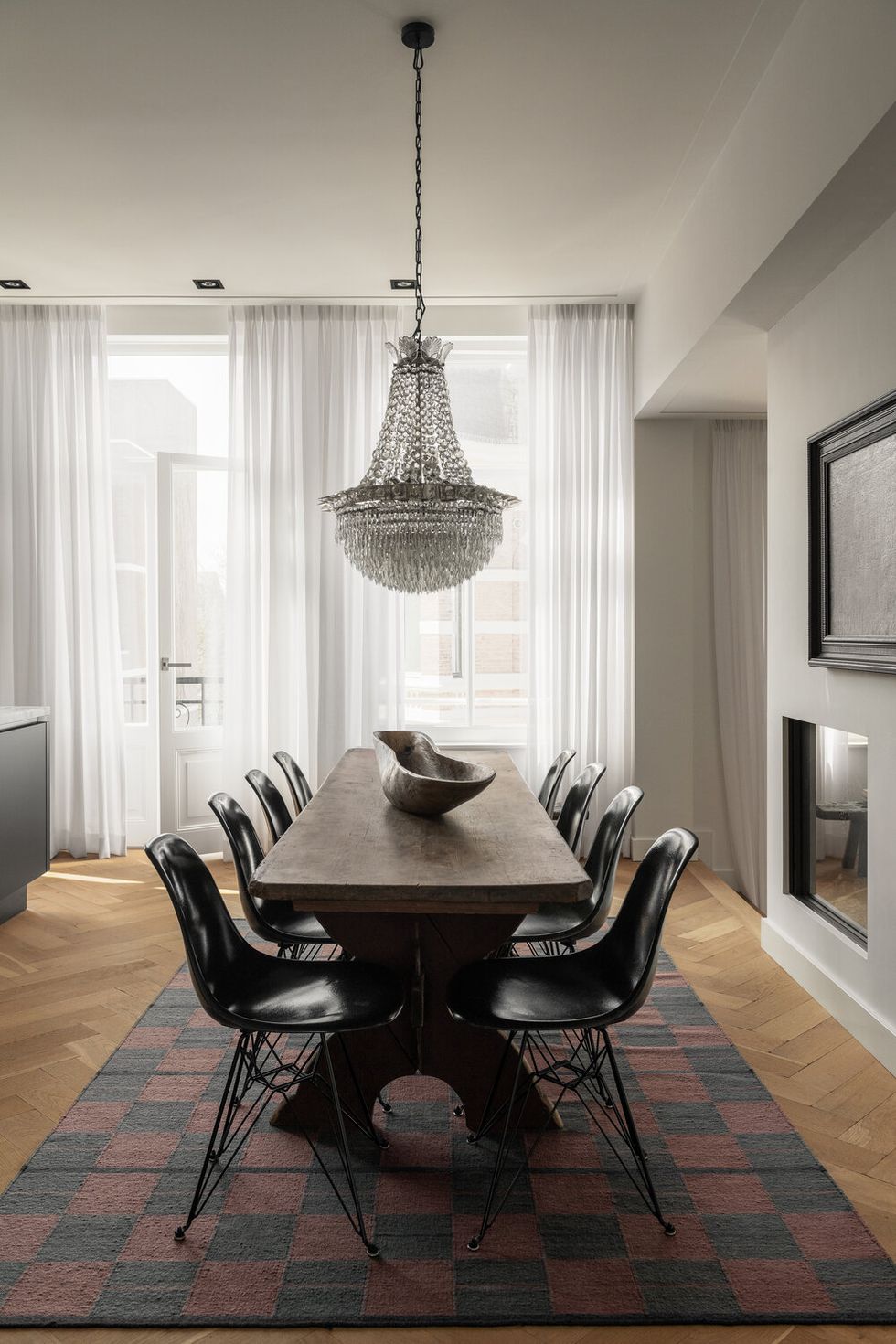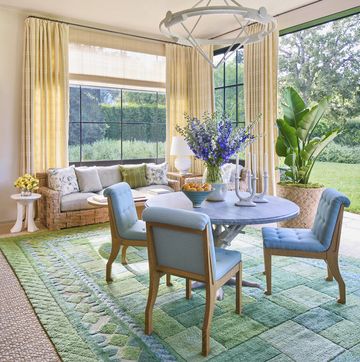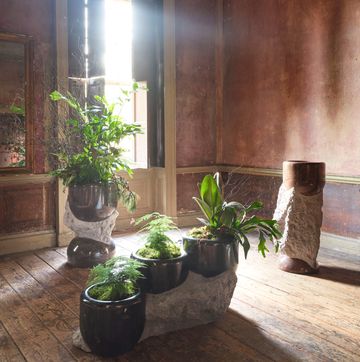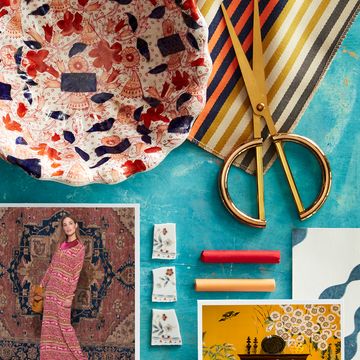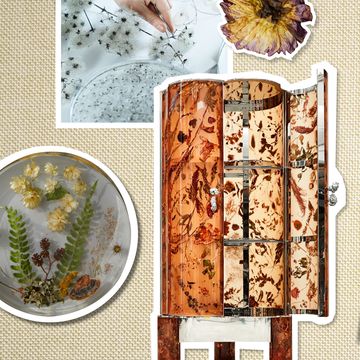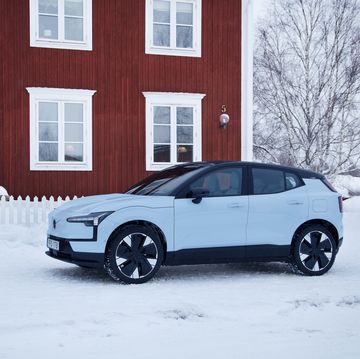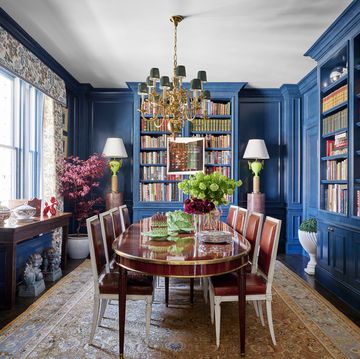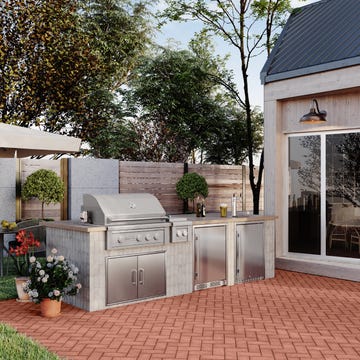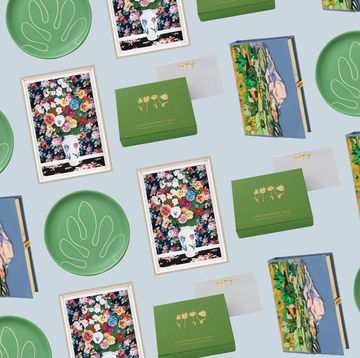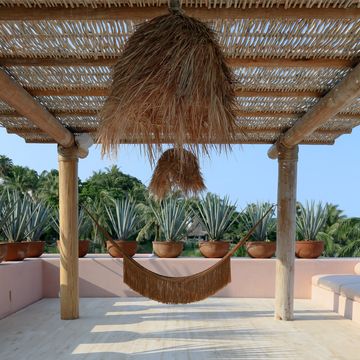Between fashion brands like Ganni, Stine Goya, and By Malene Birger dominating the style landscape; companies like Ikea bringing functional home design to the masses; and architectural firms such as Bjarke Ingels Group reshaping the way we view and build our cities, it’s clear that Scandinavian design is taking over. And we’re expecting an interest in it to continue growing as the world sees a greater need for sustainable, soul-soothing design to make our homes—and the planet—better places to live and thrive.
We talked to authors of three Scandinavian design books—Rhonda Eleish and Edie Van Breems of the eponymous design firm and home decor brand, along with Liza Laserow, a high-end Swedish antiques expert, interior designer, and cofounder of Nordic Knots—about the basic elements, history, and future of this widely misunderstood decorative arts style.
What Is Scandinavian Design?
“Within Scandinavia, there is a focus on design that supports the home and healthy living—anything that is designed is created to support that notion," says Van Breems. "That’s the mantra of Scandinavian design. Anything a furniture maker or paint colorist or carpenter does will always go back to the basics of how it will support the home and the environment and enhance one’s quality of living. It’s truly a way of life."
An important component of design-as-lifestyle is how a piece directly impacts the body. Van Breems says Scandinavian design is about much more than a piece being designed in the modern or country fashion; it’s also about how the piece complements the person who uses it. For example, ergonomics is a hallmark of Scandinavian furniture design, blending comfort and livability with modern style. The design due says Scandinavian design is also all about the materials used, and it’s equally as important to ensure they are sustainably sourced as it is that they will fit the style of your home.
“It’s more about taking life and designing to support that,” Van Breems says. “It’s any easy form of design to accommodate into your home for that reason. It’s more of a movement than a design form.” The duo notes they often use Scandinavian furniture, antiques, and design elements in everything from early 20th-century California bungalows to Park Avenue mansions to create warm, layered dwellings.
A Brief History of Scandinavia's Decorative Arts
The Scandinavians prioritized sustainable design practices long before it was cool out of necessity for hundreds of years, Eleish explains. Even though it had its day in the sun in the 17th century, Scandinavia has been poor and isolated for most of history, as trading with other countries was difficult. Eleish says this struggle meant design became regionalized, with makers and artisans utilizing materials from their own backyards for their bespoke creations, establishing a deep sense that quality materials are one with the land—something that still persists in today’s modern design aesthetic, be it the type of stone chosen for the kitchen or a paint pigment for the walls.
“There’s a misconception that [the Scandinavian design aesthetic] is all white all the time, when there is so much color to be found,” Van Breems says. “Even if you are doing white-on-white interiors, they aren’t all one color; there’s definitely a French influence there, where everything looks really layered and interesting still with various grays, ivories, and creams. With the way Scandinavians live, there’s a lot of color, and it’s more cheerful than we might imagine it to be.”
Eleish points to the illustrious history of Scandinavian—particularly Swedish—antiques to highlight the region’s long-standing love of color.
“The country furniture is not unlike Americana with deep reds, blues, yellows, and greens derived from pigments and materials of the earth," she says. "Looking at Scandinavia’s decorative arts history, there is a lot of painted furniture and decorative murals, which all have to do with their interpretation of what was fashionable at the time.”
The design duo points to the era of Gustav III, who brings his visions of grandeur from spending time at Versailles with Louis XIV and Marie Antoinette to the royal court. He also found inspiration on his Italian travels, witnessing the newly uncovered ruins of Pompeii and falling in love with the country's classical way of decorating. Both the upper-crust people who didn’t quite have the riches of nobility and rural farmers embraced savvy spins on gilding and marble with decorative painting on the furniture and walls, which the design duo says became what we know today as the "Gustavian gray period.” This style became synonymous with symmetry and clean lines, soft tones of gray and white, thick garland and ribbon as decoration, and a love for decor from the Eastern world.
Scandinavian design evolved again during the Napoleonic era as empirical influences took hold with darker-toned woods and the rise of campaign furniture. It was redefined yet again with the Arts and Crafts movement, bringing fame to beloved Swedish artist Carl Larsson and his colorful yet restrained vignettes of family life that influenced the day’s design aesthetic. In a period where one in five Swedes had fled to America due to economic stresses, famine, and harsh living conditions, those remaining were inspired to preserve their nation’s crafts and architecture, and a Swedish revival was born, with Larsson’s love for romance and tradition blended with a love for functionality and personalization.
Today’s midcentury minimalist stereotype came forth with the launch of Ikea in the middle of WWII. The pair says this really re-cemented the original principles of Scandinavian design, looking at creating pieces for the body, giving every piece a purpose, and making design accessible for all.
“Ikea became such a huge success because they mastered flat packaging and produced beautiful furniture that was both affordable and easy to ship,” says Van Breems.
The duo says there’s a misconception that Scandinavia and its designers are stuck in the Gustavian or midcentury Danish periods of design because that’s what’s often flung to the forefront with the wild popularity of Ikea and trends on social media.
“What we often see from the Scandinavian bloggers is so edited, but that’s not how all Scandinavians live,” Van Breems says. “Many Scandinavians have these very high-style, contemporary-chic apartments and houses that mix in personal artwork and antiques from a favorite period—even Bali or England. It’s all very chic, refined, and eclectic.
The Basic Elements of Scandinavian Design
“Scandinavian designers know how to take advantage of the negative space, and the layout of a room is often easy and straight-forward with a minimalistic approach toward the amount of pieces used,” says Lazerow. “There is often a lack of strong colors, but that doesn’t mean [a room is] colorless, rather muted."
Eleish echoes this sentiment, saying that the negative space offers soul to Scandinavian design, which people often don’t understand. Instead of coldness and sterility, Scandinavian spaces are livable, family-oriented, and happy places to dwell. If one takes a moment to truly observe a Scandinavian room, they can see the thought and texture and warmth of these spaces in the subtle yet elegant layering that makes it sing.
“Since we don't have too much natural light most of the year, as boring as it sounds, white walls are more common than not to reflect light and make the room feel brighter than it might actually be,” Lazerow. “With this in mind, good lighting is also a key element and extremely important to get right in this dark part of the world.” Chandeliers, mirrors, and other reflective glass make the most of winter’s short days, while bringing illumination and inviting warmth once the sun goes down. Few things can set a mood like lighting, and it is a design imperative for Scandinavians to create a space that welcomes and fosters a cozy place to spend time with loved ones.
Lazerow also says a hallmark of nearly every Scandinavian-designed home is thoughtful storage spaces that hide any possible clutter to create peace and harmony in a space. Whether that’s a set of practical built-ins for curated vignettes or a beautiful antique piece to hold winter accessories in the entryway, Scandinavians ensure storage is both beautiful and efficient.
Eleish and Van Breems share 27 various elements of Scandinavian design in their first book, Swedish Interiors. Among the most dominant are: maintaining a balance of positive to negative space for a tranquil home; cozy and restful nooks to nurture one’s well-being and imagination; rich, luxurious fabrics, like leather, linen, and sheepskin; a mix of the old and new for a one-of-a-kind space; bringing the outdoors in whenever possible; tone-on-tone (bonus points if there’s a bit of patina); and spaces that reflect one’s travels, passions, and desires.
“In Sweden, we have the word lagom that is actually an integral part of the Swedish national psyche. It’s something Swedes live by,” says Lazerow. “It affects the way we dress and how we decorate our homes. It’s a well-balanced style that's beautiful but understated.”
Van Breems says there’s something about Scandinavian design that makes you feel supported and happy no matter where you are in life. She notes the high-quality textures are beautiful and luxurious, and people naturally feel supported by Scandinavian products and design.
“Hygge is why we do things,” she says of the popular lifestyle concept. “Our homes are places you go to spend time with your people and do everything. They need to be places that you want to share with others and do life there. It’s about being cozy, yes, but it’s more than that. Scandinavian design offers a sense of things that make you feel good and surround yourself with them.”
The Globalization and Future of Scandinavian Design
The popularity of Scandinavian fashion and the rise of brands like Marimekko have allowed the world to see there is so much more to the region’s aesthetic than what one can find at Ikea, though it has its place. And as the world becomes more aware of the need for sustainable home design, more of us are looking to the Scandinavians for how to pave the way for a more conscious, comforting, and beautiful future for interior design.
“Scandinavian design in Sweden has grown and evolved so much over the past decade with a lot of new designers emerging, but the common themes are clean lines, soft and muted color schemes with a lot of tone-on-tone, and natural materials such as wood and stone,” says Lazenrow. “I think people want something easier and are tired of the clutter of unnecessary pieces that aren't useful. As an antiques dealer and designer of rugs in 100% percent wool, I vouch for long-lasting pieces in natural materials that will age well and get more beautiful with time.”
The Eleish Van Breems team says each trip to Sweden offers so much inspiration and hope for better world ahead. Among many of the makers they work with for their design firm and New England storefronts, they love the ingenuity Stockholm-based Craft Studio brings to creating a more sustainable world. The studio saved a concrete factory doomed to go under and uses it to produce decorative concrete home decor, accessories, and jewelry for the home, garden, and public spaces that can last for generations.
“What we love most is that Scandinavians are always seeing the positive in things,” Van Breems says. “They have a sensibility that balances curiosity with actually changing society and have a real entrepreneurial spirit.”
One notable thing to watch right now is the love affair between Scandinavian and Japanese design. Often called “Japandi,” the design duo has noticed a steady rise in this style of designing, which recently inspired a sustainable tourism project, Hygge Circles Ugakei, opening in 2021, which rethinks glamping at a lush site two hours from Kyoto with a focus on regeneration, biodiversity, and regional sustainability. The designers anticipate more marriages of Scandinavian and Japanese thought to redefine how we decorate, travel, live, and work for a better future for all.
“There’s so much noise in the world outside that, when you go into a Scandinavian-designed or supported space, even if it's subtle, the essence of all these qualities and this balance is huge,” Eleish says. “I think people are really responding to that because the world is so out of balance right now. You want that harmony in your home, and it's attracting more people because it’s clean, beautiful, and simple.”
She believes people are also drawn to Scandinavian design right now because of its accessibility. Creating a spectacularly cozy and layered space doesn’t necessarily require a fortune, unless you want to splurge on luxury fabrics and choose only bespoke furniture. Consumers can prioritize what they want to and blend those finer pieces with Ikea-made re-creations, which she says speaks to so many levels of the economy.
“In the future, Scandinavian design will be embraced more and more because we’ve all been through so much in these last few years, but I also feel that Scandinavian design will become more luxurious," says Eleish. "People are spending more time at home and are really seeing their need for a comfortable space because they aren’t traveling as much. There will be more investment in our interiors, especially in the quality of fabrics used and furniture purchased because they are being more lived-in.”
And as a resurgence of a love for antiques and an interest in more sustainable materials sweeps across the younger generations, Eleish and Van Breems anticipate a greater interest in Scandinavian resources, craftsmanship, and practicality. From utilization of more antimicrobial materials like copper (Sweden has one of the largest copper mines in the world), to discovering how to entertain outdoors year-round and investing in luxurious yet durable fabrics for a more comfortable home, this small region in northern Europe is sure to continue its worldwide impact.
“Everything made in Sweden is certified sustainable, and that’s been going on forever here but not everywhere else," Eleish says. "We are going to look to the Scandinavians to learn how to do this—as well as how to live, shop, eat and recycle—to live a more sustainable life in a more opulent way for a better future."

Lauren Wicks is a freelance writer and editor based in Birmingham, Alabama. Before going on her own, Lauren worked for brands such as VERANDA, EatingWell, and Cooking Light, and she covers all things lifestyle from interior design and luxury travel to wine and wellness.
